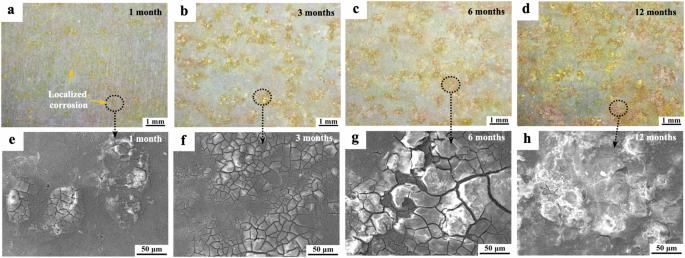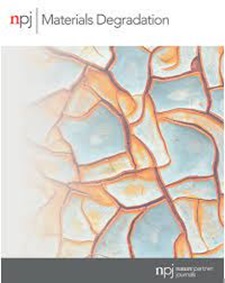Insights into the degradation mechanism of Fe-40Ni-15Co superalloy exposed to marine atmospheric and high-temperature conditions
IF 7.6
2区 材料科学
Q1 MATERIALS SCIENCE, MULTIDISCIPLINARY
引用次数: 0
Abstract
This study investigated the corrosion and oxidation mechanism of the Cr-free Fe-40Ni-15Co superalloy with exposure to a tropical marine atmosphere for one year and a subsequent high temperature of 650 °C for 300 h. The degradation behavior of the samples was evaluated based on surface characterization and analysis. In the tropical marine atmospheres, the corrosion process of the Fe-40Ni-15Co superalloy presented an initial localized type after one month of exposure and gradually developed into uniform. The corrosion products were mainly comprised of Fe2O3 and NiO, suppressing the pitting process. During the high-temperature oxidation process, all samples presented super-parabolic oxidation kinetics. Except for the initial active oxidation due to salt deposits, the corrosion products after atmospheric exposure could significantly enhance the oxidation resistance at 650 °C. An explanation for the degradation mechanism of the Fe-40Ni-15Co superalloy was developed based on the synergistic effects of atmospheric corrosion and high-temperature oxidation.

对暴露于海洋大气和高温条件下的 Fe-40Ni-15Co 超合金降解机制的深入研究
本研究调查了无铬铁-40Ni-15Co 超级合金在热带海洋大气中暴露一年并在 650 °C 高温下暴露 300 小时后的腐蚀和氧化机理。在热带海洋大气中,Fe-40Ni-15Co 超耐热合金的腐蚀过程在暴露一个月后呈现出最初的局部腐蚀类型,并逐渐发展为均匀腐蚀。腐蚀产物主要由 Fe2O3 和 NiO 组成,抑制了点蚀过程。在高温氧化过程中,所有样品都呈现出超抛物线氧化动力学。除了盐沉积导致的初始活性氧化外,大气暴露后的腐蚀产物可显著增强 650 ℃ 下的抗氧化性。基于大气腐蚀和高温氧化的协同作用,对 Fe-40Ni-15Co 超合金的降解机理做出了解释。
本文章由计算机程序翻译,如有差异,请以英文原文为准。
求助全文
约1分钟内获得全文
求助全文
来源期刊

npj Materials Degradation
MATERIALS SCIENCE, MULTIDISCIPLINARY-
CiteScore
7.80
自引率
7.80%
发文量
86
审稿时长
6 weeks
期刊介绍:
npj Materials Degradation considers basic and applied research that explores all aspects of the degradation of metallic and non-metallic materials. The journal broadly defines ‘materials degradation’ as a reduction in the ability of a material to perform its task in-service as a result of environmental exposure.
The journal covers a broad range of topics including but not limited to:
-Degradation of metals, glasses, minerals, polymers, ceramics, cements and composites in natural and engineered environments, as a result of various stimuli
-Computational and experimental studies of degradation mechanisms and kinetics
-Characterization of degradation by traditional and emerging techniques
-New approaches and technologies for enhancing resistance to degradation
-Inspection and monitoring techniques for materials in-service, such as sensing technologies
 求助内容:
求助内容: 应助结果提醒方式:
应助结果提醒方式:


